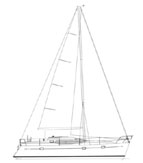Southerly 110
Coastal cruiserr
Of course in some areas shoal draft is a prerequisite if you want to venture out of the dredged channel. So with that in mind it's no surprise that a builder like Southerly in England has come up with a complete line of retractable-keel cruising yachts.
Let's start by identifying some of the problems with a retractable keel. First, it's an additional mechanism and that should lead to maintenance considerations. Second, the keel trunk can intrude upon the accommodation volume. And third, by matching the keel-up draft with the depth of the rudder you can end up with a small and shallow rudder that cavitates at low angles allowing the boat to round up in the puffs.
Probably the biggest concern, especially with today's "Ooooh, am I going to tip over?" mentality, is the question of stability. When the keel comes up so does the bulk of the ballast and a higher CG means less stability. These are all reasonable considerations. Let's see how Southerly dealt with them.
Southerly started on the right foot by hiring one of my very favorite designers, Rob Humphreys. We've never met but I'm going to call him Rob. Rob's design work combines both racing and cruising types and that gives him an edge on performance. I usually love his sheerlines, and even in this stubby design, there is some perkiness to the relatively flat sheer.
The mechanism of this lifting keel is very clever. It combines a grounding plate comprising 66 percent of the ballast, with a large-diameter stainless steel pin to pivot the keel. The keel trunk is hidden in the interior by combining it into the galley-dinette area. And the "silly little rudder" problem has been handled by using two rudders, so that the leeward rudder will maintain its effectiveness even when the weather rudder is lifting to the point where it will suck air.
Stability? Okay, here's where I raise my right eyebrow. The brochure claims that with the keel raised this design has in excess of 140 degrees of positive righting moment. But I'd have to have more data on exactly how that righting moment was calculated before I trusted it. This is not a heavy boat (D/L 221) and this is not a narrow boat (L/B 3.04). In fact, for a cruising boat it's relatively light and wide, and I would estimate the VCG of this design at about 6 inches above the DWL.Perhaps they included the volume of the entire deck, maybe even the mast. That's just fine, but it's not the way the IMS does it, which is the standard for stability comparison in this country if you want to enter an offshore race in many areas. Either way, my eyebrow is still up at that jaunty angle.
The layout is very Euro, with a big double berth tucked under the cockpit, and a head accessed from the galley area or the aft cabin. The galley looks good to me, but I wonder about those cute little round sinks. Being the cook I also like to do the dishes so that I'll know everything is clean to my standards before I prepare the next meal. It's a personal problem.
I don't have I, J, E and P for this design so I can't give you a precise SA/D but from the look of the rig it's small. Using the areas for full mainsail and genoa I get 16.05. Without genoa overlap and mainsail roach the actual SA/D must be down around 14. That's approaching motorsailer ratios.
This would be a good San Francisco boat.

Comments